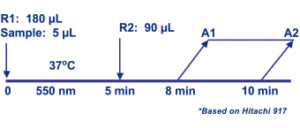Lithium Assay
Lithium Enzymatic Assay kit is for quantitative in vitro determination of lithium in human serum.
Lithium Assay provides a convenient, stable, non-caustic low cost alternative to expensive ISE and highly caustic alkaline Lithium methods. Lithium Assay demonstrates an excellent correlation with ISE methods and offers excellent precision CV% of <5% and a measuring range from 0.19 mmol/L – 3.0 mmol/L. The assay is not interfered by the following substances at indicated concentrations: Na+ 200 mM, NH4+ 0.5 mM, Ca2+ 4.0 mM, Mg2+ 2.0 mM, ascorbic acid 5.0 mM, 0.25 mM Zn2+, 0.25 mM Fe3+, 0.25 mM Cu2+, 10 mM K+, Triglycerides 1000 mg/dL, conjugated bilirubin 20 mg/dL and unconjugated bilirubin 45 mg/ dL, Ascorbic Acid 5 mM and hemoglobin 500 mg/dL.
Lithium is determined spectrophotometrically through a kinetic coupled enzyme assay system involving Diazyme’s proprietary phosphatase1 whose activity is sensitive to lithium (IC50=0.1mM). Through enzymatic coupling, the phosphatase substrate is converted to hypoxanthine by a series of enzymatic reactions to generate uric acid and hydrogen peroxide (H2O2). H2O2 generated reacts with N-Ethyl-N-(2-hydroxy-3-sulfopropyl)-3-methylaniline (EHSPT) and 4-aminoantipyrine (4-AA) in the presence of peroxidase (POD) to form a quinone dye which has maximal absorbance at 556 nm. The rate of the quinine dye formation is inversely proportional to the concentration of lithium in serum samples.

